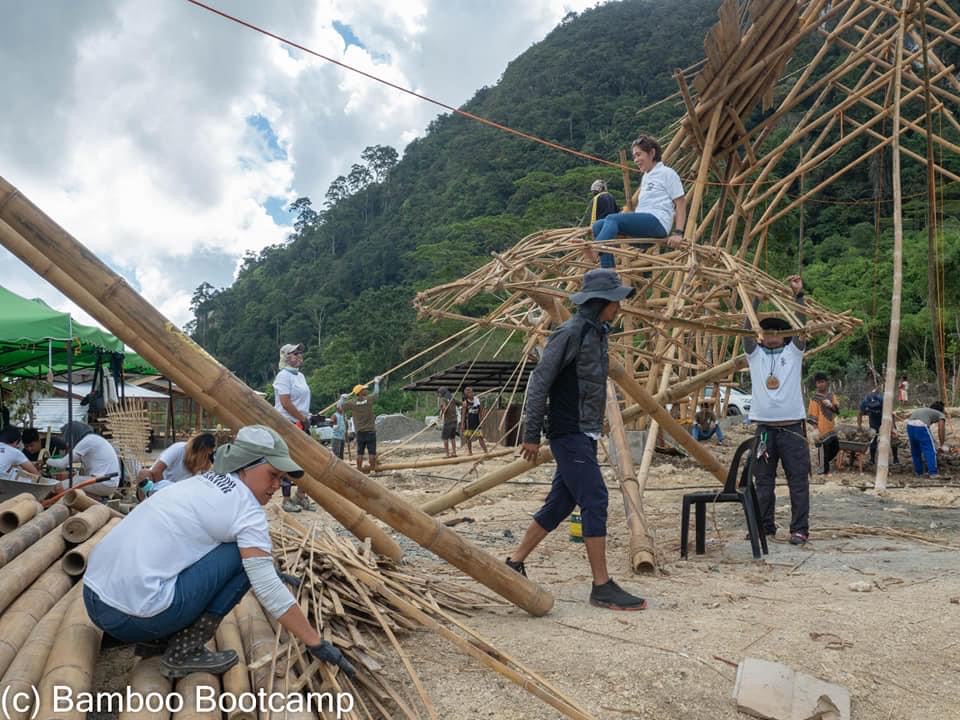
Bamboo for Bamboo Construction Innovations
Buildings that cater to tourists are generally constructed with more permanent materials and on a larger scale. This means an increase in energy needs and greater emissions of carbon. Data released by the Urban Age Project initiated by the London School of Economics, in collaboration with Deutsche Bank’s Alfred Herrhausen Society, revealed that the modern construction industry absorbs 60 to 80 per cent of the world’s energy (Burdett & Sudjic, 2011). This industry also contributes to the production of 75 per cent of the total world carbon dioxide.
Global Status Report for Buildings and Construction (2019) claims that increasing emissions and energy demand were driven by massive expansion of floor area, while efficiency improvements cannot keep up with the demand growth. Architecture and urban design critic, Dejan Sudjic, believes that architecture is an important profession to help solve this issue (Sudjic, 2011). Not only do architects make a significant contribution to the physical form of a city, their works can also be a solution to environmental problems if done right; but a threat to environmental sustainability if done wrong.
Growth in the number of tourist accommodations in Bali is soaring, in line with the growing number of tourist visits that has never decreased or even stagnated in the last 10 years. In 2017, there were 4,874 hotels built in Bali, with 11.30 per cent or around 551 of them being star-rated hotels. Most of the tourist accommodations are located in the southern part of Bali (BPS, 2019).
In addition to tourist facilities, the southern Bali area, where rain falls all year round, is more densely populated compared to the less fertile east, north and west Bali areas. Since the pre-colonial era, this part of the island has indeed been contested among the people. Today, it is becoming increasingly urbanized. This density is exacerbated by the rapid growth of the tourism industry. Both the tourism activities and the built environment raise questions around the issue of sustainability.
CAPITAL DRIVEN CONSTRUCTION
Obtaining economic benefits is the main driver of urban developments, including tourism. Globalization boosts investment, spreading construction from one region to another. Advances in information and communication technology have increasingly influenced the investment movement. Capital can move quickly from one location to another.
An informant I spoke with, who is a practitioner of hospitality management in Bali, said that investors now want a faster return of investment. They are increasingly impatient to make profits. Other informants argued that investors today also like to expedite their capital development. This is not in line with conventional construction methods with concrete as the main material.
Construction done in a conventional method requires a long time to complete. Once it has been built, pulling investment out will be both problematic and disruptive. If investors want to pull out, the unfinished construction will disturb the environment. Faster return of investment also means faster construction. Therefore, the basic material of concrete—cement, iron and sand—must be imported from outside of the area. This is not friendly to the environment and produces a high carbon footprint. Moreover, concrete, the second most-applied materials on earth, in particular contributes as the second CO2 emitter behind fossil fuel (Walsh, 2019). Around 8% of all global CO2 emission is emitted by cement industry, the main components of concrete. Faster construction is never an ideal option, but if it has to be done to meet the demands of investors, new construction techniques are urgently needed.
ALTERNATIVE MATERIALS
Architects are required to always find solutions, both to solve the investment problem as outlined above and to maintain environmental safety by reducing the footprint of building materials and construction. The main challenges in the construction of tourism facilities in Bali is meeting the needs of new materials that can be produced quickly, transported easily, constructed faster and more economically, and, wherever possible, generate income for the locals. Most importantly, it should not bring more damage to the environment. In response to investment needs and environmental safety, innovations in architecture and construction need to be encouraged.
Nowadays, there has been a growing trend in the use of materials with investment and ecological advantages. Bamboo is a viable option because of its environmental benefits compared to main building materials.
Bamboo is also easy to grow in the tropics and the harvest time is also faster than wood. Its light weight means easy processing.
However, bamboo has not always been popular because in the past, it was often identified with construction for the lower-middle class housing. The limited knowledge of construction in the past also makes bamboo unpopular and under-researched. With the increasing economy in the industrialized era and the increasing spatial demands, bamboo was slowly abandoned.
Today, sustainable development goals (SDG) and the research funding that follows have given bamboo a new breath of life. Sustainable materials are on demand. Bamboo has entered modern construction because of its availability and the practicality of its use. In Bali, bamboo is easy to find. It grows on riverbanks, in forest areas around Kintamani and in many other regions. This once-abandoned material actually meets the requirement for fast and sustainable bamboo construction.
That being said, bamboo’s identity, which was previously attached to architecture for the poor, must be worked on and rebuilt by displaying it in a more modern and sophisticated method of construction and design. Another challenge is to use bamboo in mass production.
CASE STUDY: MANDALA AGUNG, BALI
Since the use of bamboo has now changed, along with the demands of the type and size of space, it means that architects need to use their creativity to make construction modern and functional. The Mandala Agung facility inside the Fivelements Puri Ahimsa Wellness Resort complex is an example of the use of bamboo with modern construction. This facility serves as a place to practice yoga as part of the concept of being close to nature as offered by this resort.
ARTE Architects, the designer of this facility, wanted users to feel the greatness of the universe. For this reason, a conical shape was made to resemble a mountain. To enter, we must climb up steps in a narrow gap. Once inside the room, we will see a monumental scale produced by bamboo structures combined with reeds to cover the entire wall. Natural light enters through a hole right at the top of the cone. This light will move and illuminate different sides of the building in accordance with the direction of the sun, which will probably remind us of the interior of the Pantheon in Rome.
To construct such scale and create distinctive feeling of light from above, bamboo were arranged accordingly. On top of the building, 7 interconnected rings made of bamboo were positioned created a light-well. This well is supported by two layers of reed covered walls that are also the roof. Isolated the room, the walls are supported by each 9 columns made of extremely tall interconnected bamboo poles. The ring and the walls give light and shadow respectively to the interior space.
The bamboo construction technique used to make the Mandala Agung cone is not the same as that used in traditional times. The designer has arranged the bamboo in an entirely new way, creating a grand, tall room with a large floor plan without angles. Architecturally, the shape, when viewed from the outside, implies a modern expression, but the natural color of the reeds that cover the entire surface of the cone gives it a local impression. The unique creation of the space produces structures that are distinctive from both inside and outside.
This shows that with contemporary construction methods, bamboo has a great possibility in creating bigger and taller room, giving new experience to the users of the building while maintaining local sense of place. This sense of place is the value which make the island of Bali is searched by visitors.
In the hilly and mountainous Greater Ubud Area, where buildings with concrete construction means higher costs, bamboo is becoming a popular alternative. Its use is not only for yoga facilities, such as those used in Mandala Agung, but also to fulfil other typologies—restaurants; schools, such as the Green School; settlements, such as the Green Village; villa units; and other facilities. In addition to new construction, bamboo stems and poles are also needed to renovate old buildings.
OTHER ADVANTAGES
In addition to the architectural advantages, bamboo also creates a new ecosystem for the economy. In Bangli area, central Bali, bamboo is being replanted massively. Increased construction of new facilities by utilizing bamboo has led to increasing demand. Communities plant bamboos so that they can gain the economic benefits. Additionally, bamboo replanting helps save river banks from landslides. Bamboo forests also provide oxygen, functioning as the lungs of the densely populated South Bali.
The science of bamboo construction is now resurfacing. Two decades ago, no young generation was interested to study bamboo. Now, there are countless numbers of graduates of architecture who specifically research and specialize in bamboo design. Workshops on bamboo workmanship are also booming, which pass on the knowledge of bamboo construction from/to craftsmen. This generation has become the renaissance of the once-forgotten local wisdom that is the Balinese bamboo construction knowledge.
All in all, bamboo is not only sustainable but also equitable choice. The material is abundant because it grows fast; sustainable because it produces low footprint and easy to construct; and versatile because it can used in almost any design. In terms of technology advancement, research on preservation techniques is growing and it propels construction creativity. Bamboo architecture is also trendy as it is now featured as part of a five-star hotel building or other exclusive facilities.
FUTURE RESEARCH on BAMBOO CONSTRUCTION
However, there are always two sides of a coin. Bamboo is growing in popularity today and it has a positive impact on the environment, the economy and the social welfare, but there is a big disadvantage. In the past, bamboo buildings were often classified as semi-permanent so they did not require formal permission to build. The practicality of bamboo construction and its ability to be built in difficult areas—on the edge of a cliff, a sloping land and river banks—means that they can be erected in a prohibited area. This needs attention from the government. They need to immediately revise regulations related to bamboo building typology. Today’s bamboo building type is different from the past, which was mostly small, so new regulations are urgently needed.
Another challenge is the effort to propose bamboo so that it can be developed for public housing. So far, the trend of modern bamboo construction reaches only tourism facilities. Although its image is slowly changing from architecture for low-class society to hotel resorts for the upper class, it has not been popular enough to be developed for mass housing. Research from universities should seek to explore the possibility for this development. Bamboo may not be a single answer to sustainable construction. However, it potential could be an effective alternative to concrete.
** The Bamboo Bootcamp is a Bamboo workshop for anybody with the LOVE and Interest in Bamboo and on a mission for a sustainable ecosystem. Farmers that want to propagate, professionals who want to see its properties as a strong building material, Craftsmen who want to learn how to work with it, Enthusiasts who want to learn of its many uses, Arts & Crafts Lovers who want to learn how to use Bamboo as a medium and Entrepreneurs, LGUs and Business People who can see the opportunity for livelihood. The Bamboo Industry fulfils the 17 Sustainable Goals set forth by the UN, thus allowing participants to indulge in building a better world through Bamboo.


I grew up in a large bamboo house back in Iloilo as a child but have lost touch with how to best use bamboo these days. I’m excited to learn new construction techniques and other possibilities.